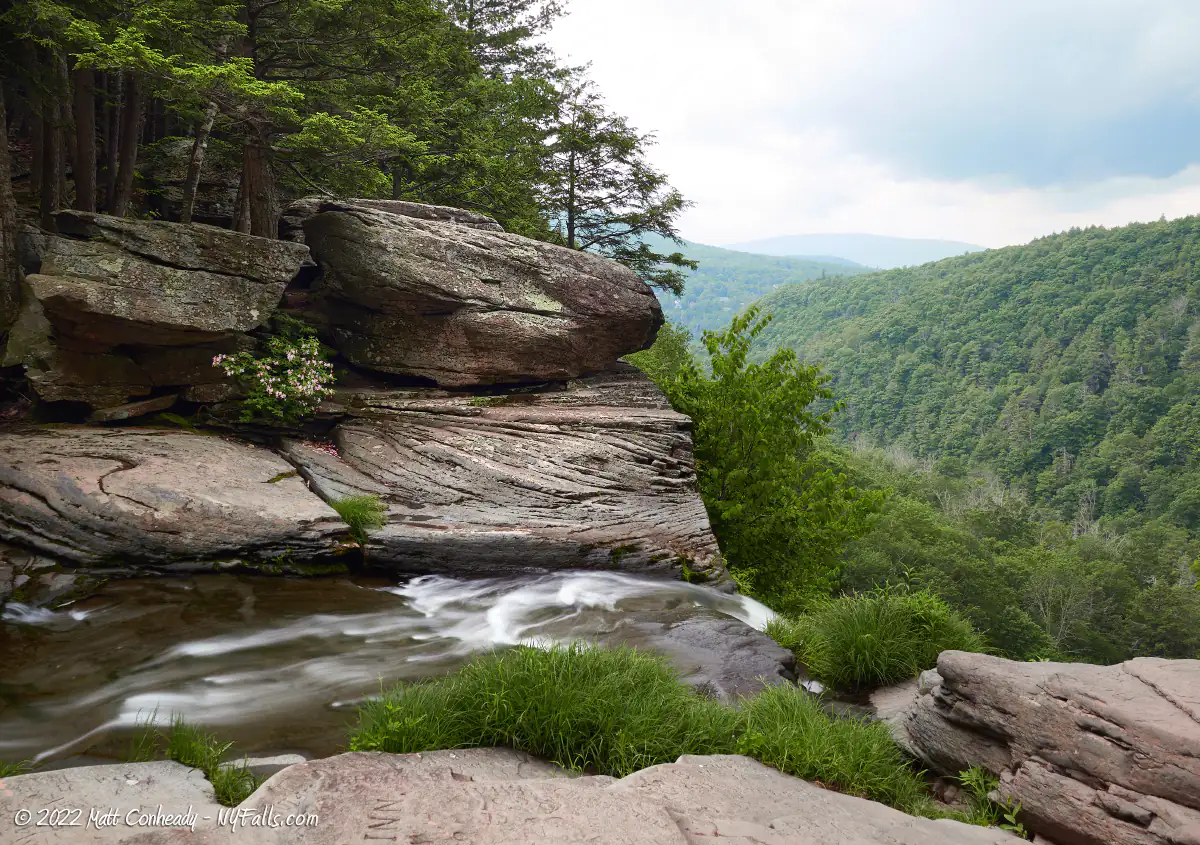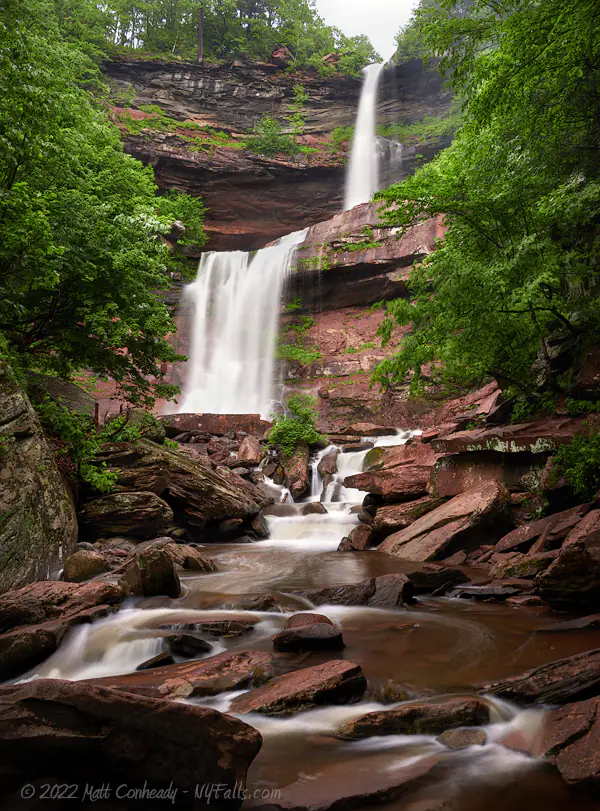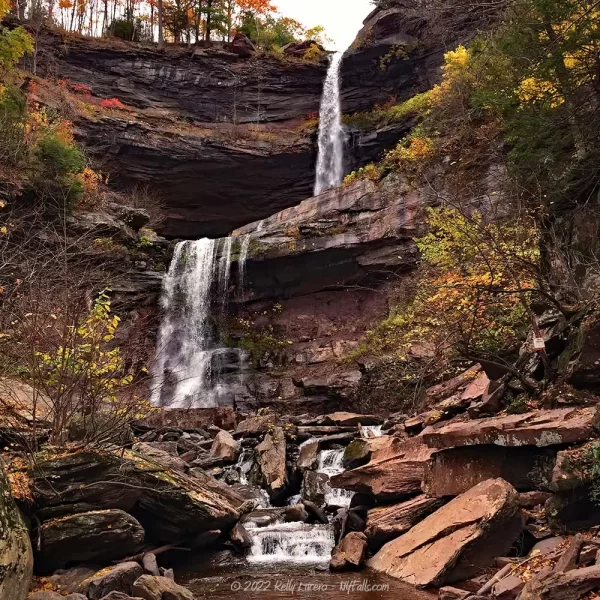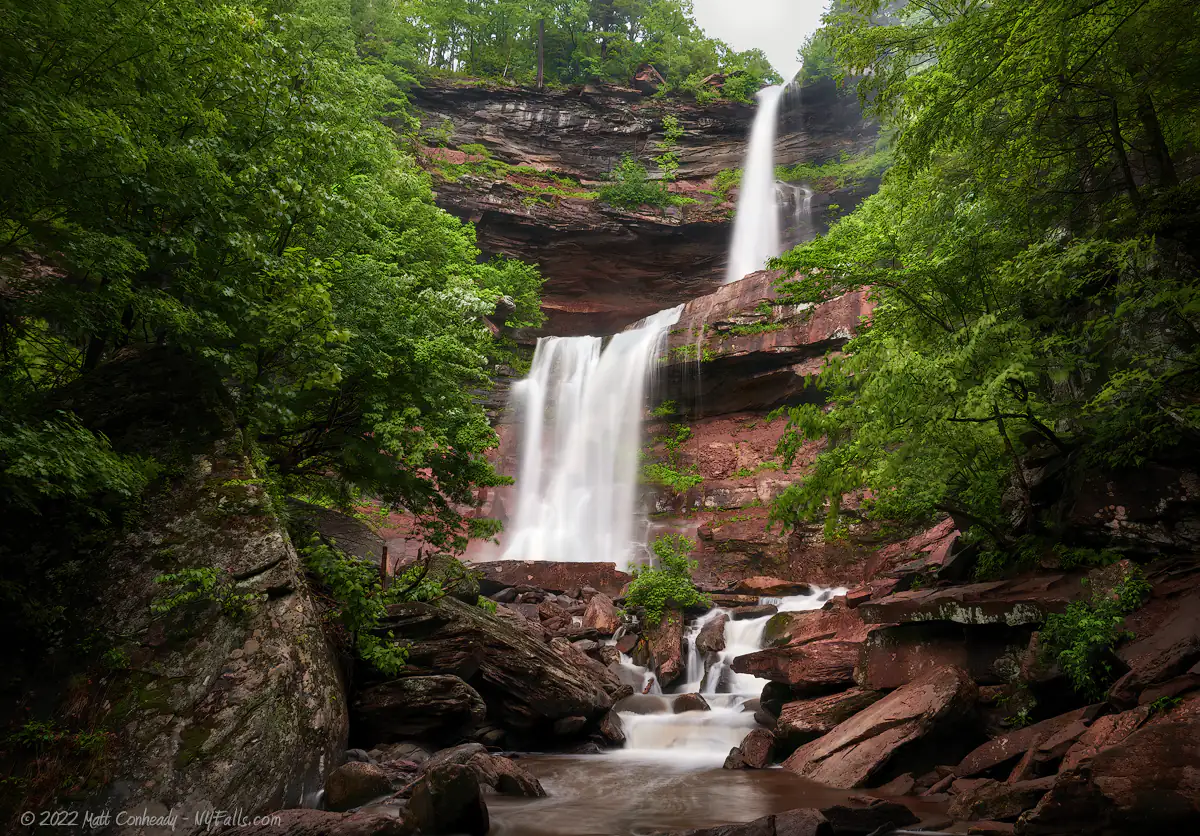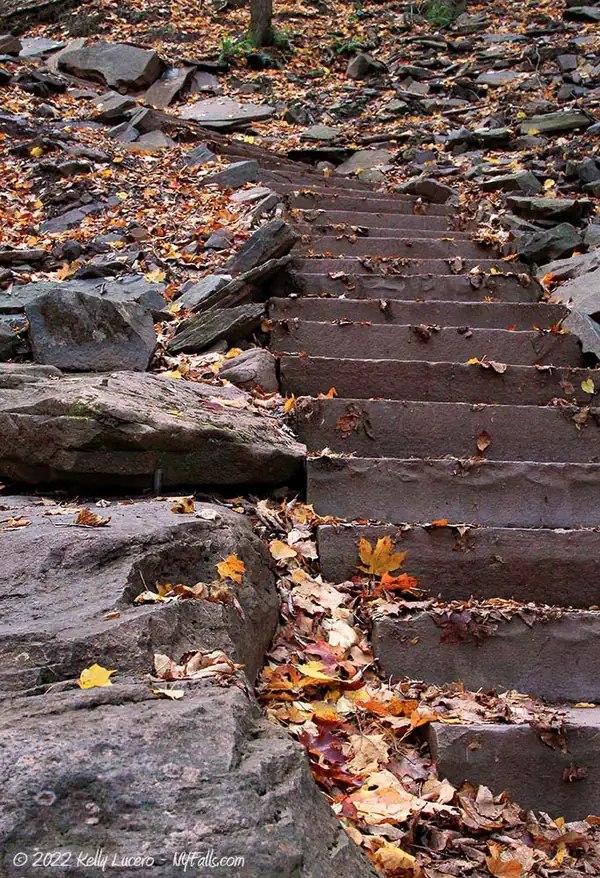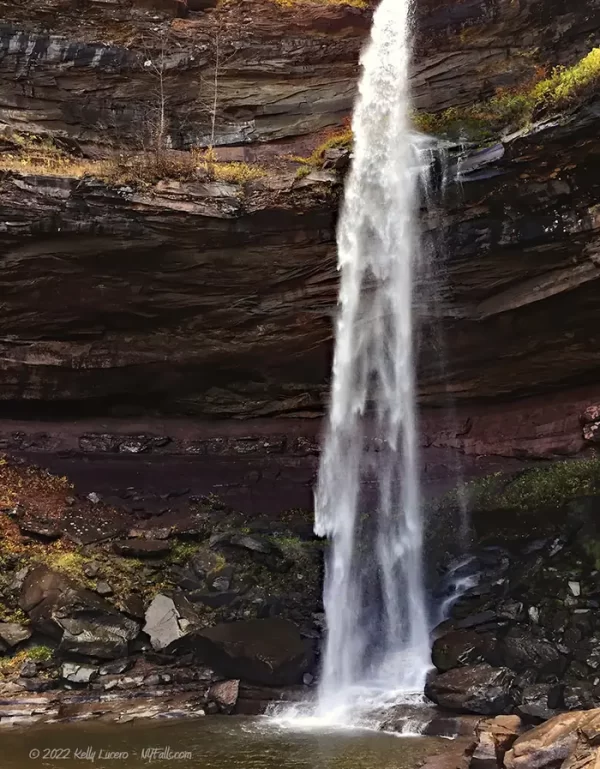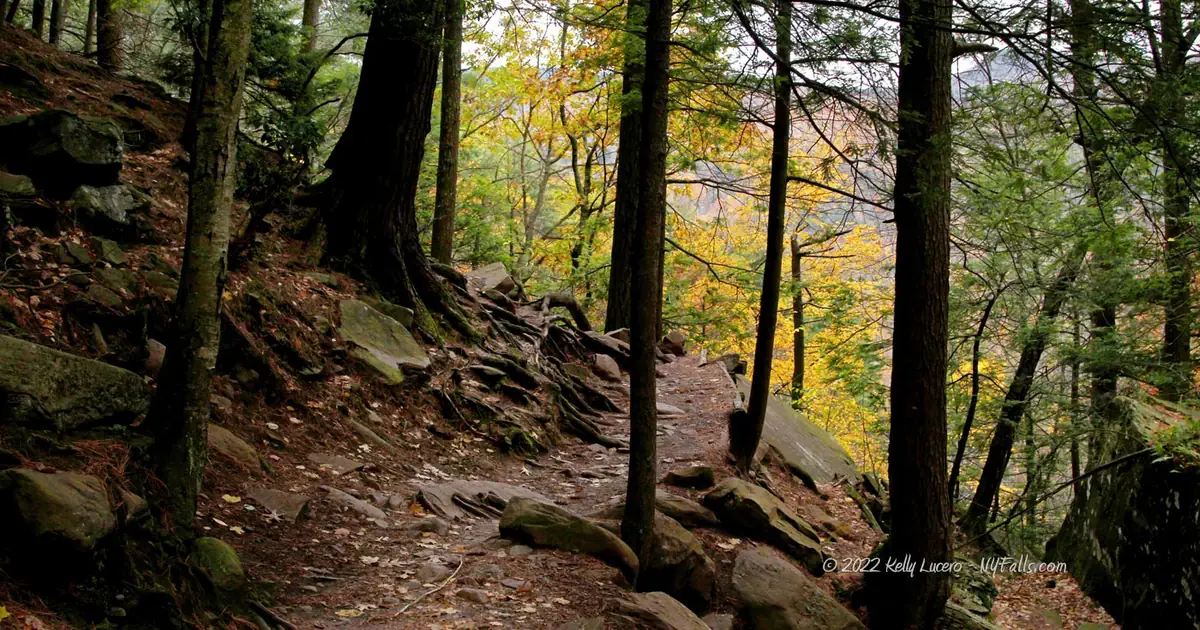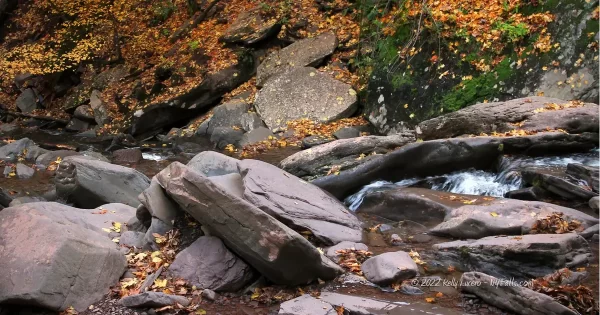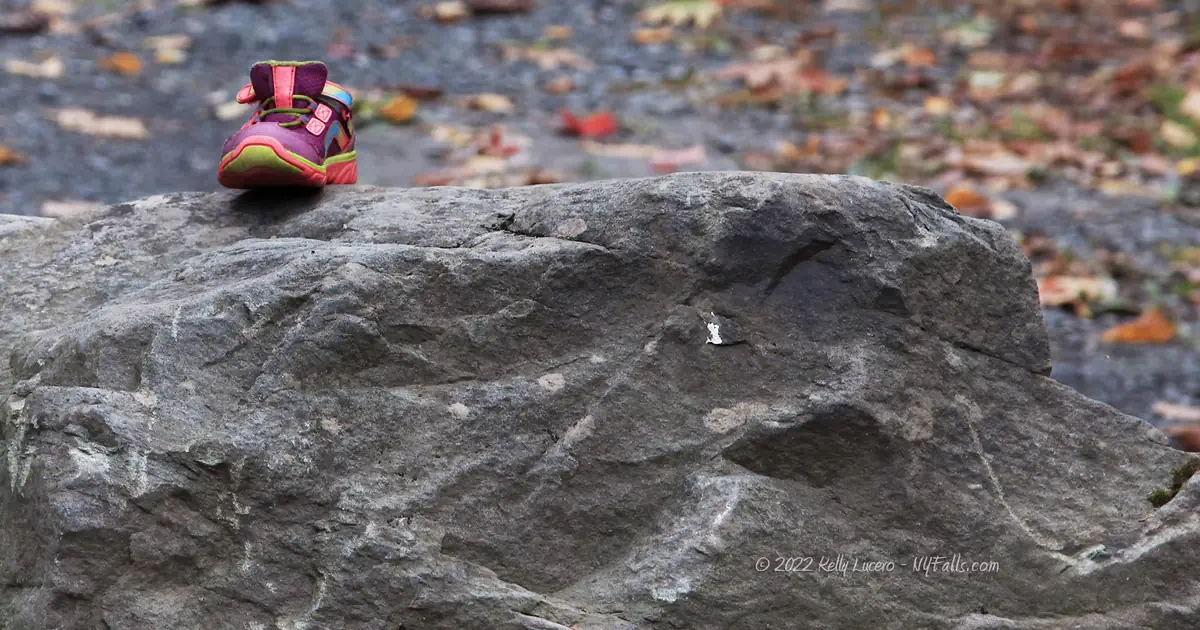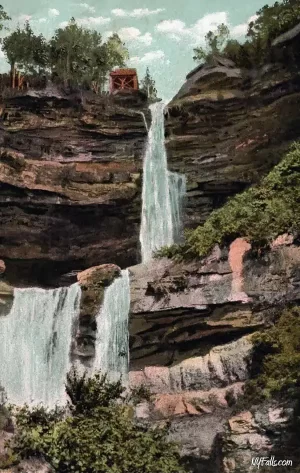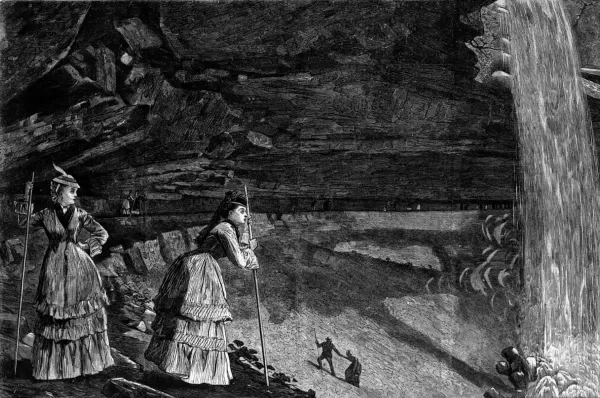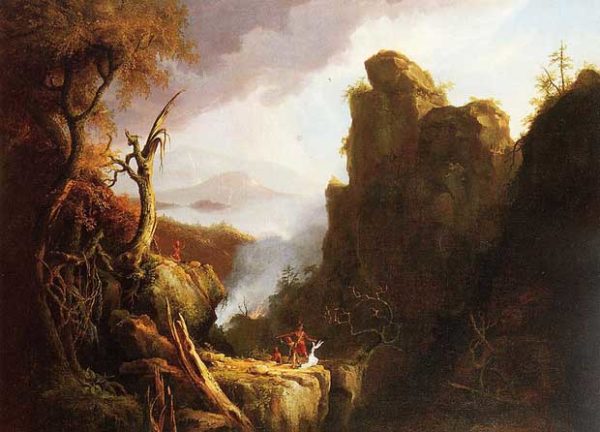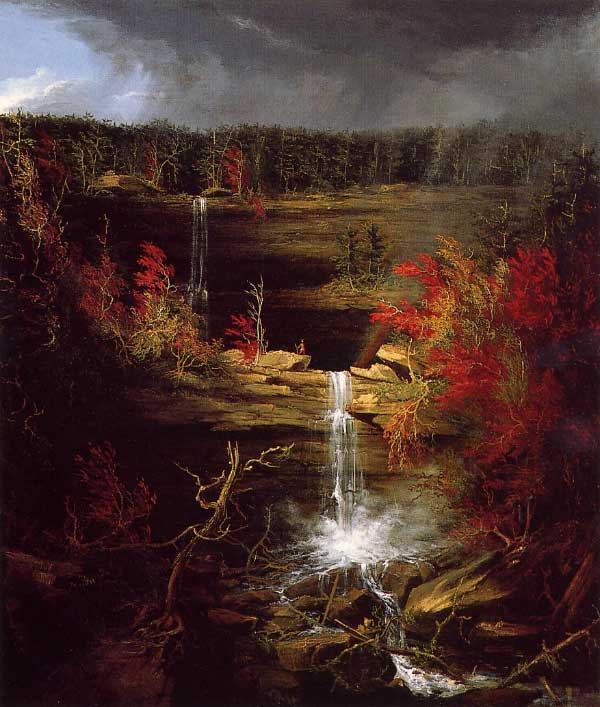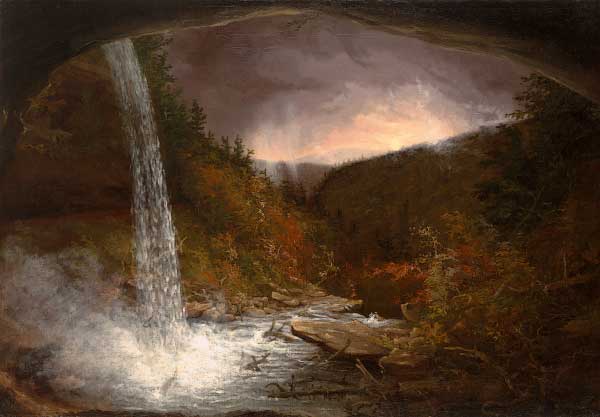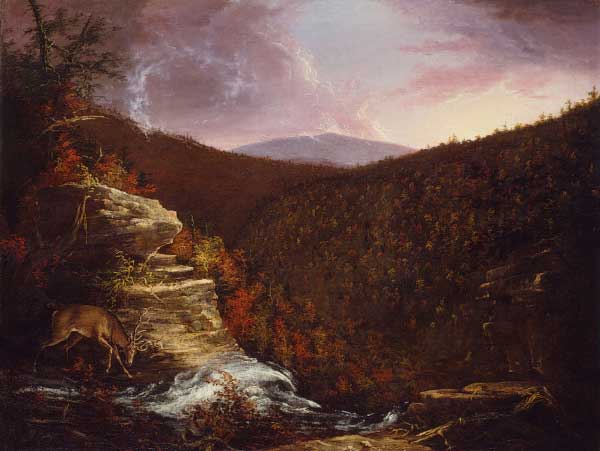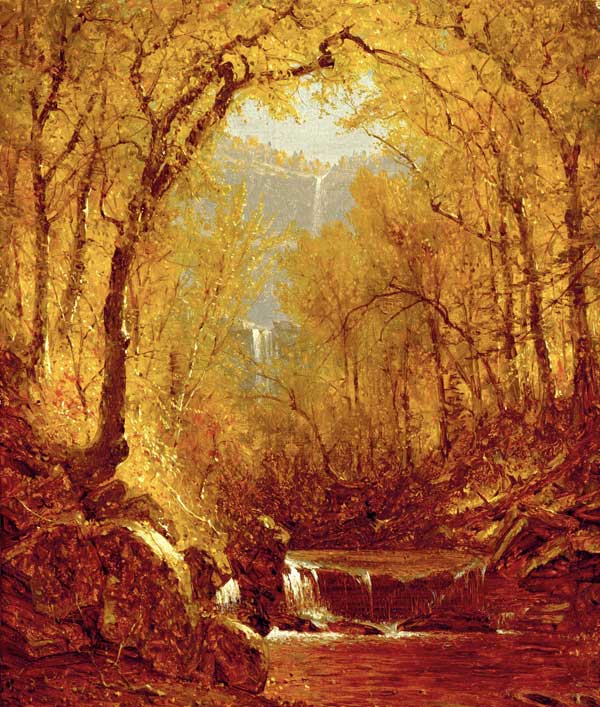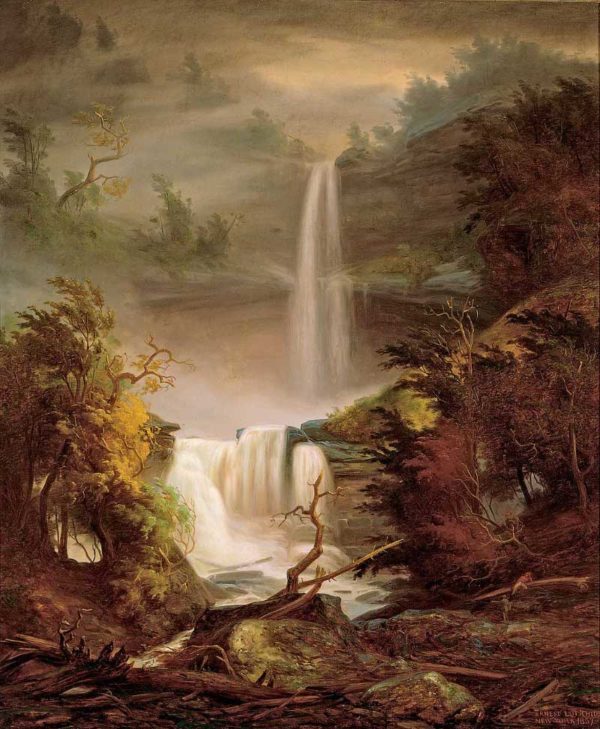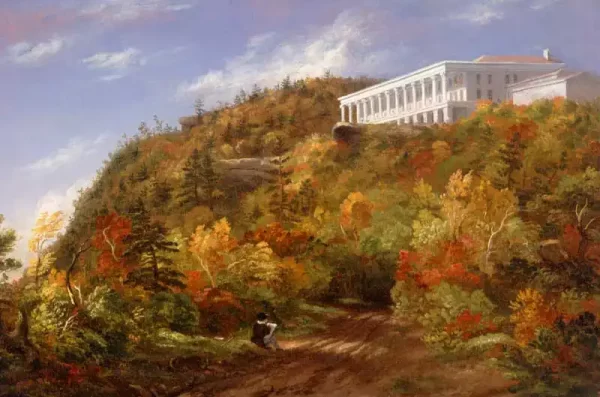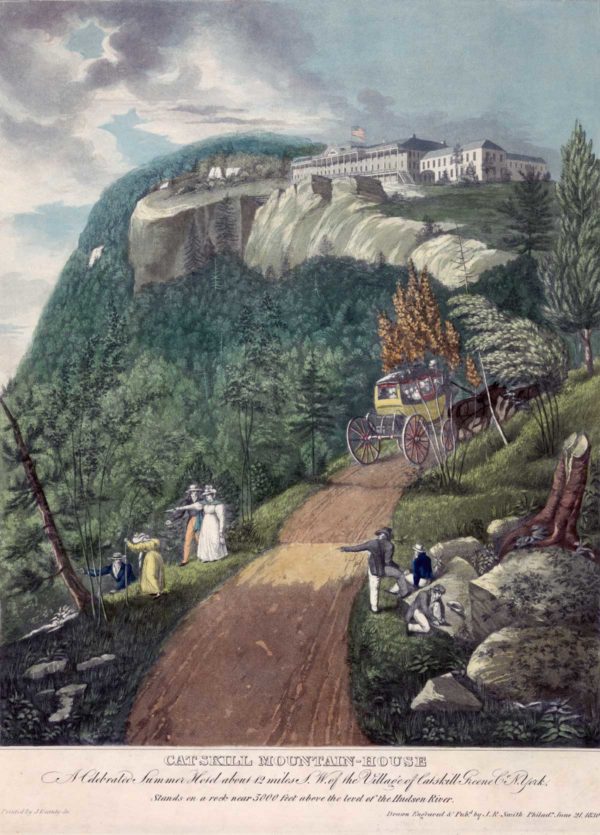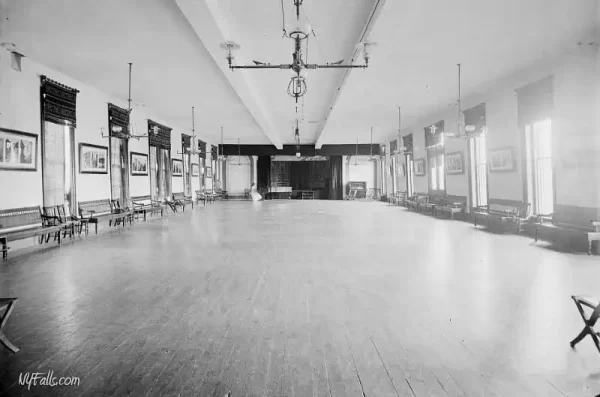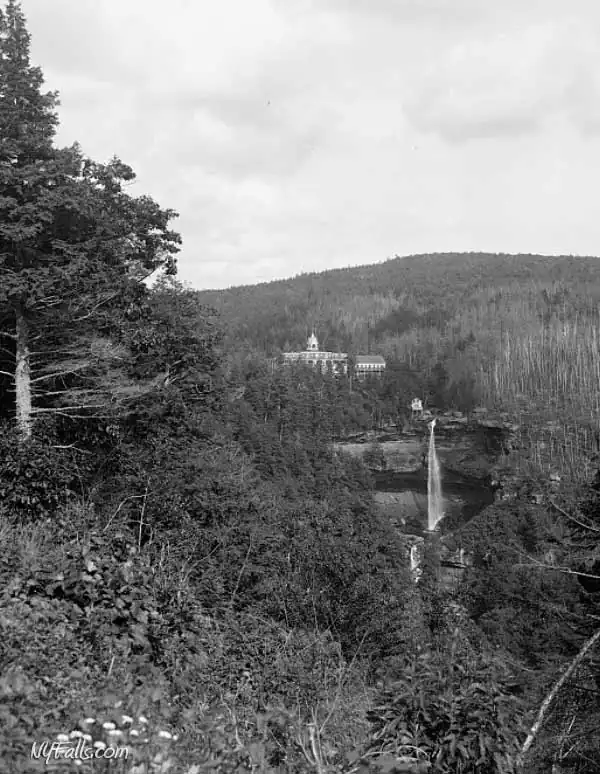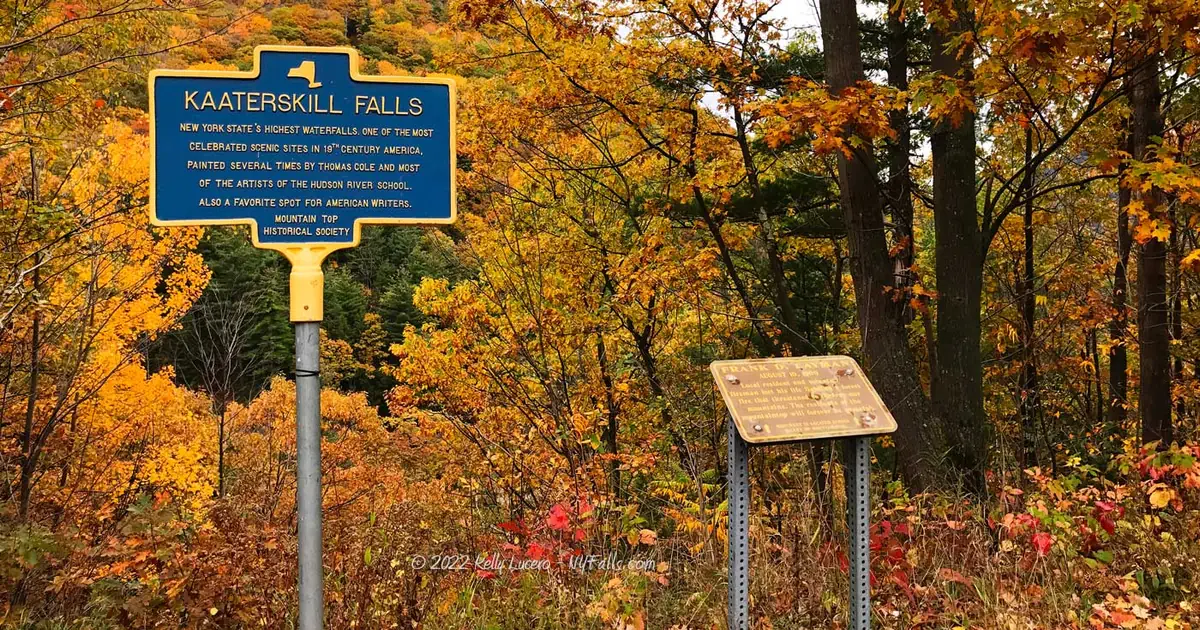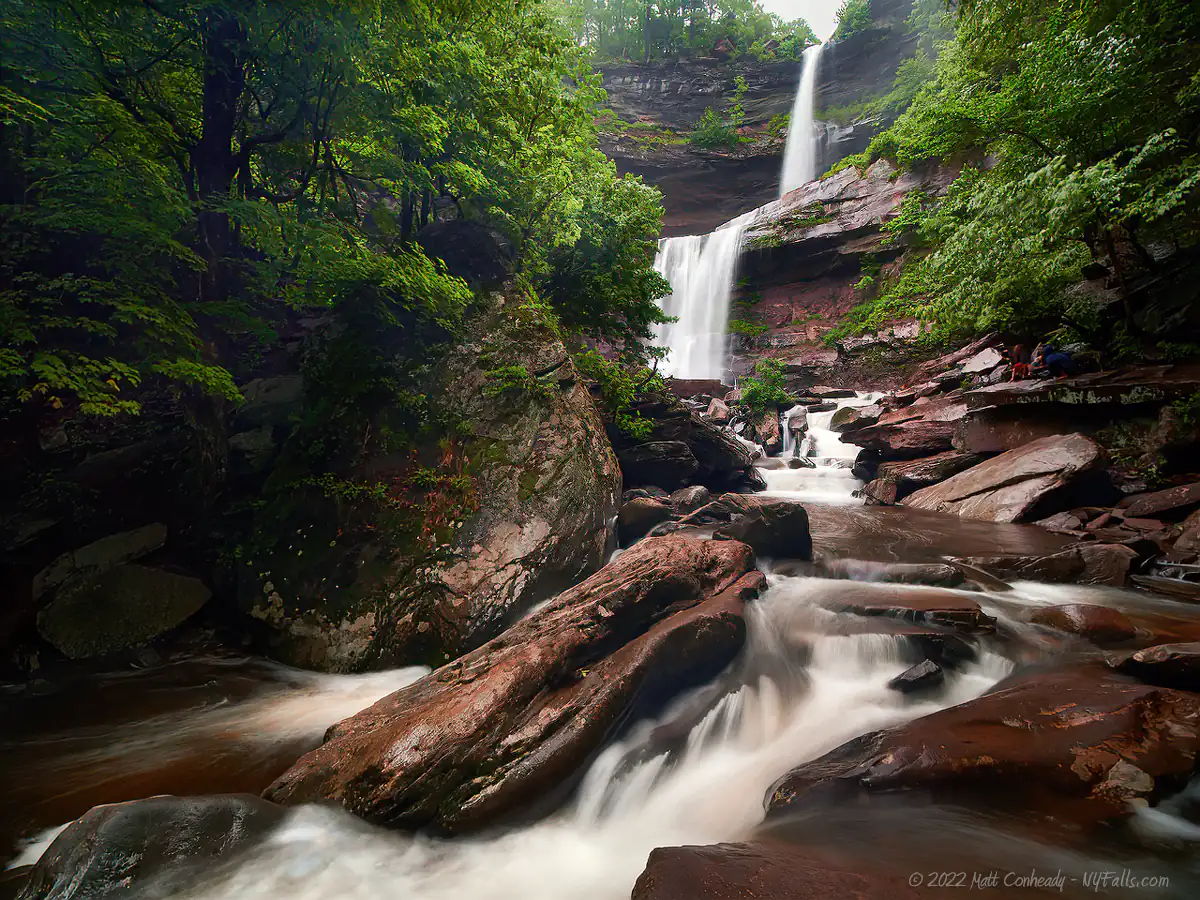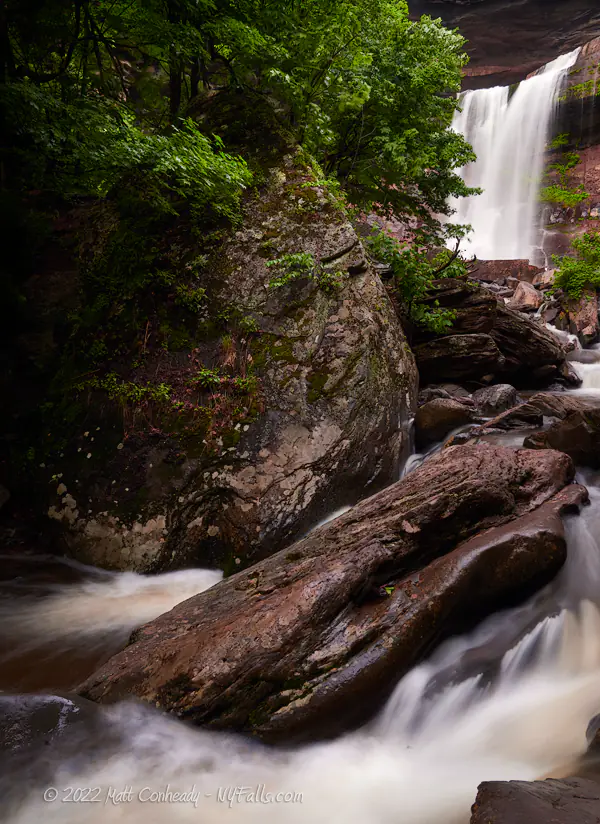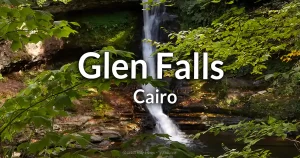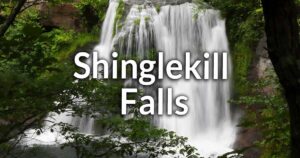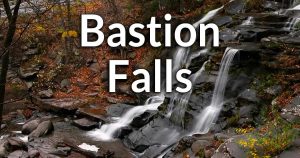Kaaterskill Falls
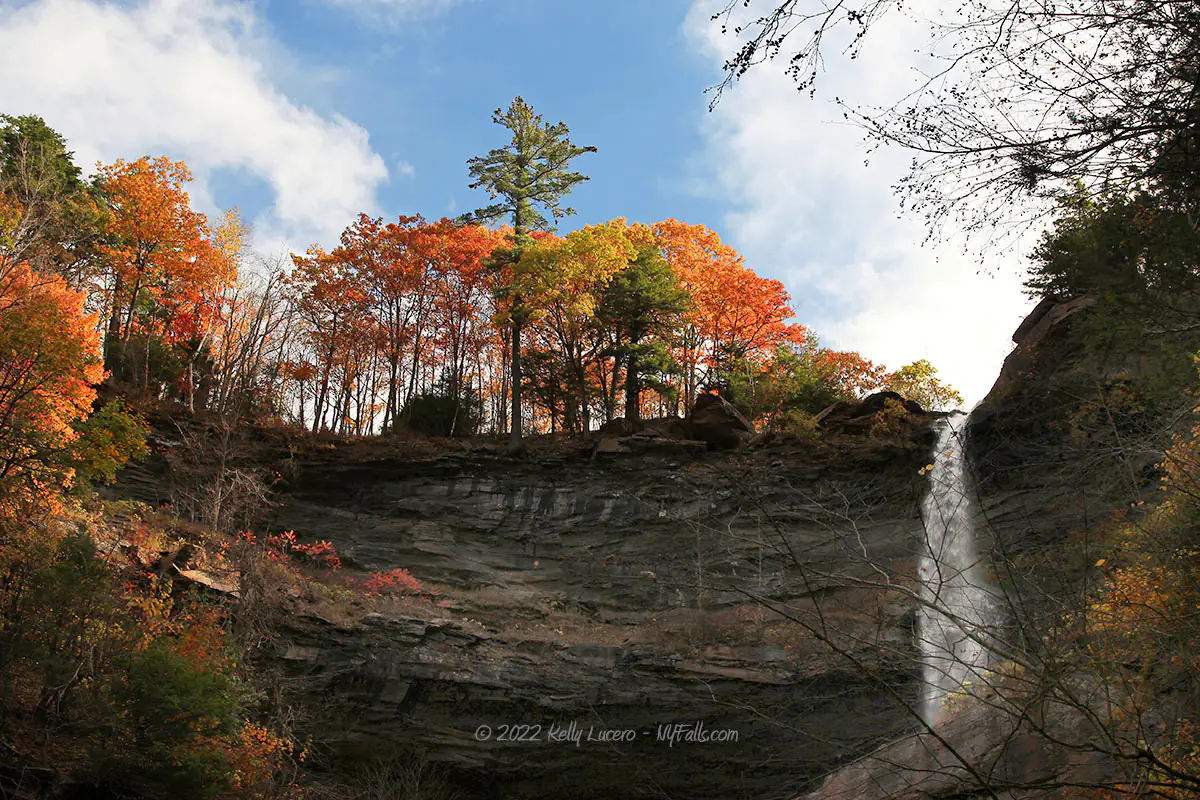
Location: Within Kaaterskill Wild Forest in Catskill Park (also known as the Catskill Forest Preserve); Town of Hunter; Greene County; New York.
Near the hamlet of Haines Falls.
Maps: Google Map; Topographic; Kaaterskill Wild Forest DEC Map; NYNJ Trail Conference Map; Interactive map.
GPS coordinates:
- Kaaterskill Falls: N 42.19332, W 74.06345
- Nearest parking area: N 42.19574, W 74.06330
- Overlook: N 42.19393, W 74.06354
Directions: While the park has several entrances and a large network of trails, there were typically 2 that were used for access to the falls specifically. The downstream parking lot off of CR-23A, near Bastion Falls, often called the Molly Smith parking lot, is closed until further notice. The primary parking lot you should use is found upstream at the end of Laurel House Rd.
Take CR-23A into Haines Falls and turn onto CR-18 (N Lake Rd). It will go north for a bit and then off to the right at the Twilight General Store. Follow it for 1.8 miles and then turn right onto Laurel House Rd. It will end at a parking area for the park.
Use Google Maps to get you there.
Parking: The parking area on Laurel House Road can accommodate over 20 cars and typically has a set of port-a-potties. At the south end of the lot is the trailhead that leads down to Kaaterskill Falls and the viewing platform.
Parking is not allowed on NY-23A, as it is narrow and people never slow down. The Molly Smith parking area along that road is also closed, probably permanently. The town will tow you if you park along NY-23A.
Alternative parking can be had at the Escarpment Trailhead to the east.
Or the Scutt Rd Trailhead to the north.

Weather
Information / Accessibility / Accommodations
Number of falls: 1 (Bastion Falls is further down this trail or viewable from NY-23A)
Size/Types: Kaaterskill Falls is a 231 ft tall waterfall consisting of an upper narrow plunge (167 ft tall) and a lower, wider plunge (64 ft tall) over a u-shaped cliff face. The basin below the falls is littered with boulders, small and large, creating a few smaller cascades as the creek continues down into the valley.
Bastion Falls is a 0.4 mile hike down from here. That trail is currently closed. Bastion Falls is be covered in another guide.
Best time to visit: Spring through fall.
Flow: Moderate. It has been known to dry up in late dry summers.
Waterway: Spruce Creek, which begins about a mile and a half to the north at North Mountain, flowing south and through North and South Lake prior to reaching Kaaterskill Falls. It turns west just before the falls and then turns south again after Bastion Falls and joins Kaaterskill Creek shortly after. Kaaterskill Creek cuts a narrow gorge, known as Kaaterskill Clove, as it enters the Hudson Valley at Palenville. It does its own U-turns as it turns north after Palenville, back south just shy of Kiskatom, back north again at Asbury, and then finally to the east as it merges with Catskill Creek. Catskill Creek then runs through the village of Catskill and into the Hudson River. The Hudson flows south to New York City and the Atlantic Ocean.
Time: Allow for several hours. Try not to take the hike down late in the day as it may be dark and thus more dangerous on your way back. Most importantly check the hourly weather for the time you expect to be on this trail as it can get very muddy and slippery during rain.
Seasons/Hours: No hours are posted, but for safety: dawn to dusk, 7 days a week. The trail may be closed in winter or icy conditions, or if there are landslides. This place can get really packed on summer weekends. If you want to enjoy yourself without the crowds, plan on an early morning weekday trip.
Admission: Free.
Handicap Accessibility: None.
Pets: Leashed pets are allowed in the park, but because of the danger not only to your pet, but to other hikers along these narrow slippery trails, do not bring your pet on difficult hikes. Remember that you are liable for any injuries/damage caused by your pet, including rescue operations.
Accommodations: Trails, port-a-potties, historic signs, a bench or two.
Description
AKA: Catterskill Falls, Cauterskill Falls
Along with Niagara Falls, Watkins Glen, Letchworth, and Taughannock Falls, Kaaterskill Falls is a must-see New York natural wonder. One of the oldest tourist attractions in the region, this iconic Catskill waterfall is nestled within the Kaaterskill Wild Forest, a 7,620-acre preserve where the mountains meet the Hudson Valley. Packed with wildlife, awesome sights, and miles of adventurous trails, the preserve is just a fraction of the 700,000-acre Catskill Park (often called the Catskill Forest Preserve).
At over 231 feet in height, the falls is made up of a narrow ribbon-like torrent that drops 167 feet onto a rock shelf, surrounded by a curved, amphitheater-like gorge. From there it widens and plunges off a short and wider 64-foot drop into a pool below. While commonly this is where most sources arrive at the 231-foot calculation, already putting it as the tallest non-seasonal waterfall in the state, it doesn’t stop there. From the pool below, Spruce Creek continues downward rapidly tumbling over the stone piles from centuries of erosion and rockslides and over several small shelves in the bedrock. Take this into account and you have a 260-ft drop in total.
It’s not just the height that has fascinated visitors for centuries. Its layered appearance, and bold bedrock fractures obfuscates portions of the falls, no matter where you stand, lending an air of mystery. Despite a highly trafficked trail paralleling the creek, it’s mostly hidden, letting the surrounding forest frame the waterfall while the towering stone cliffs project its mist and roar forward. Kaaterskill Falls’ surrounding terrain has made industrial development around it difficult, leaving it in a more-or-less natural setting, reminiscent of the era of unbounded exploration and uncovering of the New World’s secrets. It’s a world-class tourist destination protected from concrete and fast-food chains by cliffs and trees.
It’s no wonder that poets, painters, essayists and photographers made Kaaterskill Falls the subject of some of their best work.
New York State recently rehabilitated and developed many of the natural trailways to the falls. They did this in part to aid tourism, which, since the grand hotel era of the latter half of the 1800s, was mostly for the outdoorsy. People were making these treks, enjoying and sharing their experiences. They were also getting hurt and sometimes killed making the climb, or simply being irresponsible. With new widened trails, clearer signage, stone steps, blasted away rock, and most importantly: warning signs most people ignore, the falls are reaching a height in tourism that hasn’t been seen for about 80 years. With that came more hikers jumping in the waters and sitting on the edge over a 167 foot fall to their death. An increase in foot and auto traffic on NY-23A became so dangerous that the Molly Smith parking lot and trailhead at Bastion Falls was closed. Artists and photographers now have to work around the folks who strip down and make the pool at the base of the falls their own personal refreshment. Ranger patrols increased. Instagram pics get riskier. People still get hurt. Some still die. The county would be doing a disservice to close down this quintessential Catskill experience. Although, if you visit their web page for Kaaterskill Falls, they do prominently direct you to “find an alternative waterfall hike.”
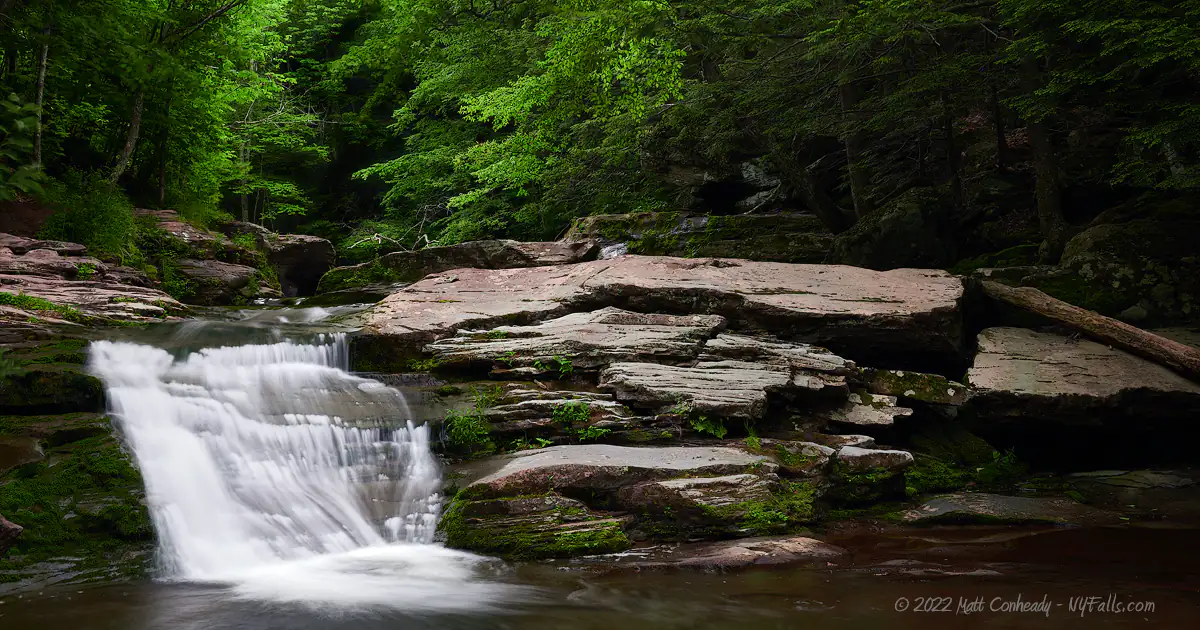
Hiking / Walking Trails
Difficulty: Moderate. The path down from the Laurel House parking lot to the observation platform is gradual with a reasonable amount of steps. It’s mostly gravel and labeled well enough. Continue down to the falls itself, and you will face more of a challenge with exposed stone, roots, and steep steps. In winter, use spikes.
Markings: Trail signs. Some yellow blazes for Kaaterskill Falls trails and blue blazes for the Escarpment Trail (which you will use to get to the lower portion of the yellow trail.
Distance: From the Laurel House parking area, to the brink of the falls and the observation platform: 0.26 miles.
From the observation platform down to the base of the falls: 0.67 miles.
The hike up from the former parking area on NY-23A (the trail that starts at Bastion Falls) is not accessible at this time. Due to hiker and road traffic, and the danger, the trailhead off of NY-23A is closed. You can still hike down from the Laurel House site to Bastion Falls, which will be covered in another guide.
Description: There are many parking and trail combinations you could take. I’m going to outline a recommended route only. Study the map below and work out the route that works best for you.
- From the Laurel House Rd parking lot, head down the gravel pathway towards the wood information kiosk. At the Kiosk, snap a photo of the map with your phone. This is the Yellow Trail.
- Follow the signs downhill to Falls Viewing Platform, Escarpment Trail, Lower Falls.
- When you reach the junction with the Blue Trail (known as the Escarpment Trail), continue on the Yellow Trail towards the Viewing Platform.
- Keep following the signs for Viewing Platform. You will hear the falls and see informational signage as you approach.
- From the platform, you can see the falls from the top north side. We will then head over to the crest.
- From the platform, head right/south towards the Blue Trail and Lower Falls. After about 0.1 mile, at the turn, you will come across a series of danger signs and a wood fence. Just past this is the very top of the falls. These multiple warnings are there for good reason. Every once in a while someone who feels the rules don’t apply to them goes and walks up to the brink of the falls, and ends up dead at the bottom. Still, a lot of people head down to the creek here, and they do so at their own risk. If you choose to do this, avoid getting close to the edge.
- Continue around the bend and follow the signs to Blue Trail (Escarpment Trail) and Lower Falls.
- Cross over the creek on the footbridge (you are now on Blue Trail) and make a right towards the junction to Lower Falls.
- This part of the trail is relatively straight, but very uneven with many rocks and exposed roots. Watch your step as you go and continue on the Blue Trail for 0.1 mile to the junction with the Yellow Trail (this is a different yellow trail than the one you came from).
- Make a right at the junction to proceed on the Yellow Trail towards Lower Falls.
- The Yellow Trail will head down into the gorge west for 0.17 mile then switchback and head northeast for 0.14 mile. There are a lot of stone steps along this stretch.
- At that point you will reach an offshoot that takes you to the rock platform between the two drops. This offshoot of the trail is uneven, narrow, and slippery. If you decided against common sense and brought your pet on this hike, best not to take them on this dangerous tangent. Everyone else, use common sense and stay away from the edge and walking into the powerful plunge of the falls. Like with the brink of the falls, people have died being stupid here.
- Continue on the downward Yellow Trail for a few hundred feet to reach the base of the falls.
At this point, keep an eye on the clock to make sure you have enough daylight to make it back safely. The climb up takes a lot longer than the climb down.
You have the option of continuing downhill/west on the Yellow Trail for 0.36 mile to get to Bastion Falls. This will take another hour or two and involves some steep terrain.
Map: Kaaterskill Wild Forest DEC Map; NYNJ Trail Conference Map; Interactive map.
Kaaterskill Falls/Bastion Falls Interactive Map
History
The name Kaaterskill likely originates from the Dutch, who were the first settlers in this region. It means Big-cat Creek. It is likely named after the Bobcat, Lynx, or Eastern Mountain Lion species that would have had territory in this region prior to industrialization of New York State. It’s pronounced “Kahter.”
Early History
While native populations were most certainly aware of the falls, the Catskills were not settled due to their elevation and supposedly poor agricultural opportunities. Tribes such as the Mohicans and Mohawks likely came into the mountains for hunting expeditions. A 1753 expedition by naturalist John Bartram and his son William led to one of the earliest written accounts of the falls.
Haines Falls
The hamlet of Haines Falls (named after the waterfall off of Wingate Rd) was originally called Haines Corners, after the Haines family. Brothers Samuel and Elisha Haines were the first settlers of the town of Hunter, migrating from Putnam County due to religious persecution, arriving in 1779. They constructed a log cabin on a small beaver pond, giving rise to the settlement’s original name of “Beaver Dam.” They returned to Putman County to collect their families and their possessions and made their way back to their new home, arriving in 1780. Maps and records show the hamlet was predominantly descendants of the Haines family through the 1800s.
Vite, the Ghost Dog.
Like many of the well-known waterfalls around the world, Kaaterskill Falls has a “someone leapt/was swept over the falls” legend attributed to it. This one is a little different. In 1868 a group of hikers left their spaniel, Vite, at the top of the falls as they hiked to the bottom. The dog was alone and panicked at the top, eagerly awaiting his human companions to come back. As soon as he saw them in view, he barked excitedly and leapt over the falls to his death. The owner, dismayed, carved an epitaph into the rocks near the falls. There are many variations of the story, and most involve the dog haunting the gorge.
It’s unknown if this tale is indeed true. The New York Times ran a story on it on September 1, 1901, 33 years after the incident supposedly took place. The article was simply a retelling, and didn’t have any eye-witness reports or photographs of the carved epitaph.
Lotowana Love Triangle
This one is a little out there. Here’s an account from History of Greene County, New York by J. B. Beers & Co. (1884):
Of the few legends that are preserved concerning them, we have only room for the following, which is the substance condensed from recollections of a recital of it made forty years ago by a descendant of the old Dutch settlers:
“About the time of the settlement of this vicinity, there lived an Indian chief who bore the name Shandaken, who is said to have occupied, during the warm season, the table rock upon which the Mountain House, on Pine Orchard, stands. This old chief had an only daughter, whose beauty excited the admiration of all the young braves and the envy of all the squaws in the neighborhood. Lotowana, for that was her name, was sought for by many a warrior of high rank in the circles of the forest. But the proposals, which were frequently made to Shandaken for the hand of his daughter, were uniformly rejected, for she was already betrothed to a young chief of the Mohawks. Among those who were captivated by the charms of Lotowana was Norsereddin, who boasted descent from an ancient race of Egyptian Kings, and who lived somewhere upon the banks of the Katskill. This young man had little to recommend him to the favor of any one, either in possessions or character. Haughty, morose, unprincipled, cruel and dissipated, he still possessed and invincible determination to accomplish his purposes that recoiled not from the use of any means that lay within his reach. This graceless man had been moved to attempt to conquest of Lotowana’s heart, simply by a banter of a Dutchman at a primitive tavern, where they were enjoying the sweets of the proverbial beer and pipe. The Dutchman had offered to wager 1,000 pieces of crown gold that Norsereddin could not win the affection of Lotowana from her troth, and although the proud Egyptian scorned the regard of the Indian girl he declared that he would take the wager and make the one who offered it rue his presuming folly.
“Norsereddin repaired at once to the mountain and spent six months in hunting, fishing and shooting with Shandaken, improving the while every opportunity to engage the favor and confidence of the chief and his people. By his seductive manners he was able to make fair progress as far as the chief and others were concerned, but with the dusky damsel he was assured by no such measure of success. In fact, while he evidently failed to awaken any tender regard for himself in the heart of the girl, he found to his chagrin that his own heart was becoming enchanted by her winning graces. So now Norsereddin had a double stimulus to the prosecution of his design, a thousand crowns of gold and a wife, that if he could not introduce with pride to the circle of his Egyptian friends, he could take delight in here amid the seclusion of the new world. He at last asked for the hand of Lotowana, but great was his mortification when he found himself rejected. Repeated assertions of his love, which were now made in all sincerity, were met by steadfast refusal, until his wounded spirit was aroused to its former imperious and haughty mien, but to his remonstrances the old chief replied: “Go, my son, there are smiles for thee among the daughters of thine own race, they are fair, and will rejoice in thy coming. The child of the red men would not forget her home. She has been nursed amid the voices of the forest, and the tall trees have cast their shadows upon her soul as over a pure stream. The music of their leaves has lulled her for many moons, and her heart is full of their strange language. Her dreams have been haunted with the croak of the raven and the scream of the panther, and still she has slept in security under the branches of the tall oak, until the images of the forest have become as apart of her own being—she would not forget them, and would sigh to return. Let my son but reflect, too, that the sunlight of her spirit falls toward the camp of the Mohawk, and its shadow, even now, darkens in his own pathway. The light of the glad sun, which proceedeth outwards continually, is the truth of the Manitou, carrying joy to the hearts of his people. It returns not, like a false light, ere it has fulfilled its promise, but goes on into the darkness beyond the world, gladdening it with hope. Shandaken would have his word like the truth of the Manitou. It has sown joy in the heart of one, let it not return unfulfilled, that the finger of scorn should point at him, and shame come upon him in his old age.
Norsereddin in reply attempted to justify the breach of honor which he had urged Shandaken to commit, but this only called out a more indignant reply for the chief. Finding himself hopelessly foiled, the Egyptian became enraged and attempted to strike down the chief upon the spot, but Shandaken hurled him away with such force that he fell upon the rock almost insensible, and the Indians who were near, following up the movement, drove Norsereddin from the camp. The latter now vowed revenge, and gave his mind to the conception of a plan, which, having devised, he forthwith proceeded to put into operation.
By the help of an old domestic he obtained the fang of a serpent, and securing it upon a piece of wire, he arranged it in a very pretty little box in such a way that when the box should be opened the wire would spring out an strike the fang into the hand of the person holding it. To make its work doubly sure and effective he charged the point also with some powerful mineral poison. Thus provided he set out for the Indian camp on the day preceding that set for the marriage festival of the lovely Lotowana with her Mohawk chief.
The summer was in its full bloom of richness, and nature smiled in the freshness of her garb of verdure and hazy purple. Every feature of the landscape seemed to flush with conscious joy, but the heart of Norsereddin comprehended it not, for it was absorbed in the execution of a diabolical purpose of revenge. On reaching the mountain he greeted Shandaken with this cunningly devised address: “Brother, I have come far this morning to greet you with the words of kindness. Let us be friends. It is not meet that you, who are a prince among your people and I, who am the scion of a race of kings, should be at enmity or war. If I have done any thing that has offended you, forgive my rashness, and charge it rather to the sudden heat of blood than any settled purpose to do you wrong. The Dawn of Day was beautiful exceedingly—I was blind and frenzied—that passion is now dead, or lives only in my recollection of its folly. Let us forget the past, and as we once were so let us be friends again. Here is a casket, and there are jewels in it that would grace a diadem. I have brought them for Lotowana, the loved child of the Wagbinga chieftain, ere she departs from the wigwam of her father. Let her accept them as a peace offering from her brother, so shall he remember her with gratitude, and invoke a blessing on her in her new home. Go, give them to the maiden, and I will depart with the breath of peace upon my lips.”
To the Shandaken replied: “It rejoices our hearts that our brother says peace. We harbor no evil against the pale-face—he is our friend; and as the mist of the morning fades before the sunlight, so melts our anger before the smiles of our brother. We accept the gift he has brought for the young maiden, as a pledge of his friendship, and are glad that he will bury his anger. It is good—let there be peace, so shall we think of him with kindness; and when he departs from us our blessing will follow him.”
Norsereddin, having delivered his message, retired without delay, while the chief went to deliver the casket to his daughter. She at once opened it, and in doing so was wounded by the fatal dart. Screaming with pain she called her father, who examined the infernal machine and saw through the scheme of which they had been made the victims. So effectual was its action that, notwithstanding all possible efforts were made to counteract the poison, the expectant bride in a few minutes lay dead at the feet of her father. Twenty warriors at once set out in pursuit of the wretched deceiver. Mounted on trusty horses, they sped down the mountain side and across the slopes with the swiftness of the whirlwind. But little did they gain on the fleet-footed charger of Norsereddin until the latter, when near the Kalkberg, stumbled and fell. To extricate himself from the entanglement of this position and remount took time that gave the pursuers advantage, and before he could regain his flight he was overtaken. The Indians now pinioned him, placed him on his horse, and proceeded with him back to their camp. A consultation was held and it was decided that he should be committed to the flames. The spot selected was upon the flat rock in Pine Orchard, but a few feet from the edge of the precipice. Over-whelmed by the prospect of death before him, he plead wildly for mercy, but he plead in vain. The pile of fagots was prepared, the victim thoroughly bound and place upon it, and the torch applied. As the hungry flames which were his winding sheet, lapped around the body of the helpless wretch and intensified the surrounding darkness, the savages danced around it, while their shouts of exultation mingled with the wails that the agonies of death wrung from the victim of his own revenge.
The body of Lotowana was buried amid the mourning of her friends; and on the following day Shandaken removed from the spot, to which he never more returned; while the ashes of Norsereddin were left upon the rock untouched, to be scattered hence by the four winds of heaven.
Grand Hotels, Tourism, and Fried Chicken
Considered one of America’s grand hotels of the 19th century, the Catskill Mountain House opened in 1825 on South Mountain, near North and South Lake, overlooking Palenville and the Hudson Valley. It was legendary in its role as a gateway to the Catskill wilderness for writers (such as Washington Irving) and artists of the Hudson River School, as well as one of the top general destinations in the New York region.
The Laurel House was constructed by Peter Schutt (a successful tavern and inn owner from Saugerties) above Kaaterskill Falls in 1852 with a modest 50 rooms. It saw a major expansion from 1881 to 1884, which allowed it to serve up to 300 guests, as well as offered a viewing platform next to the top of the falls. The hotel took liberty in developing the land around the falls, building a massive set of wooden stairs down to the bottom, complete with a deck near the base of the falls. They even installed a crane and pulley to lower refreshments from the refreshment cabin at the top of the falls to guests at bottom. The Creek was dammed, creating a pond on the property, and the hotel charged customers to lift the dam for a short time, releasing a torrent of water over the falls.
In the summer of 1880, patent attorney George Harding, vacationed at the Mountain House with his daughter, who was abstaining from red meat. On one particular day, the hotel was only serving roast beef, and would not cater to Harding’s daughter’s request for fried chicken. The polite request turned into an argument, which then turned into Mountain House owner, Charles Beach, getting involved. Still, the answer was “no.” Enraged, Harding spent the rest of his stay scouting the grounds and studying operations at the hotel. He later purchased a piece of land on the peak of South Mountain and opened the Kaaterskill Hotel in 1881, which probably served fried chicken 24/7. It competed heavily with the nearby Mountain House in what was referred to as the “Fried Chicken War.” Harding and Beach both died in 1902, ending the great war.
The Kaaterskill Hotel burned to the ground on September 11, 1924, some accounts say by a kitchen fire (chicken grease fire, perhaps?).
The Catskill Mountain House saw a massive decline in business up until WWII, and soon closed its doors in 1941. The state purchased the property in 1962 and the hotel was demolished in 1963. It’s now a historic site.
The Laurel House continued operations until 1965. It was then acquired by the state and demolished in 1967.
Thomas Cole and the Hudson River School
In 1825, Thomas Cole, an American-English engraver (by trade) and painter moved to Catskill, NY with his family. In the next year or two he explored and sketched many of the landscapes of the region. Between 1826 and 1829 he painted several of those sketches, two of which were of Kaaterskill Falls. There are 5 Kaaterskill Falls paintings by Cole, that are known. These paintings have become iconic views of the falls and his work was the foundation for the Hudson Valley art movement that would follow in his footsteps.
Cole is commonly considered the founder of the Hudson River School, which wasn’t a school, but an art movement of American landscape painters, heavily influenced by romanticism. Their works reflected three themes: discovery, exploration, and settlement: aligning with the character of 19th century America, but with signs it was soon coming to an end. The visual style depicted beautiful and dream-like natural features, sprinkled with as much majestic lighting as they were with humanity’s encroach.
As implied by the name, most of the art from the movement focuses on natural features found in the Hudson River Valley, as well as the Catskills, Adirondacks, and White Mountains. As the movement grew, artists expanded their source of influence and inspiration into New England, the American West, and even South America. Following in Cole’s footsteps, Frederic Edwin Church, John Frederick Kensett, and Sanford Robinson Gifford were notable members of the movement, and went on to help found the Metropolitan Museum of Art in New York City.
Interest in the school lasted several generations, but waned in the 1960s.
State Ownership
Much of the land that makes up Catskill Park was purchased by the state in 1921 for use as a forest preserve.
Kaaterskill Falls Media
Videos



Interesting Stuff
Bestseller
The book, Kaaterskill Falls: A Novel, by Allegra Goodman and published in 1998, is a fictional story about three Orthodox Jewish Families’ struggles balancing tradition in a secular world. The story has very poetic descriptions of Kaaterskill Falls and other natural landmarks nearby. It was a finalist for the National Book Award (1998) and a New York Times Notable Book (1998).
Haines Falls Station
On the western terminal of the Kaaterskill Rail Trail is the former Ulster and Delaware Railroad stop for Haines Corners (the former name of the hamlet). Constructed in 1913, it was the busiest stop on the Kaaterskill Railroad branch, serving the summer resort traffic on the escarpment. It was constructed to replace the original station (built in 1883), which tourism at the time, far outgrew. The station was abandoned in 1939. It was restored by the Mountain Top Historical Society and listed on the National Register of Historic Places. It’s located on the Mountain Top historical Society’s campus off of NY-32A.
Full view of Kaaterskill
There are a few ways to catch an unobscured glimpse of the whole falls, but not from this preserve.
Photography Tips
Copy Cole
- Thomas Cole’s paintings of Kaaterskill Falls are iconic, but not quite realistic depictions. Here’s a challenge for you: try your best to replicate his compositions, perspectives, and moods.
Make your own iconic views
- Avoid taking the same old tourist views. Look for and explore new angles and new scenes to capture in your own style.
Wipe the mist
- Even from a distance, Kaaterskill Falls kicks up a lot of mist, coating a lens within minutes and blurring photos. It’s difficult to avoid, but you can plan for it. Bring a folded soft cotton or microfiber cloth and keep it in a dry spot. pull it out and buff the lens frequently to keep it clear. The water in the mist is by no means distilled and may contain dirt and sand that can scratch a lens. If you are worried about this, put an inexpensive UV/protective filter on the lens to absorb any potential damage.
Silky Water Effect
- To get that smooth cotton-candy look to the falls, you need to use a Neutral Density (ND) filter on your lens. The ND filter will block some of the light from entering the lens without altering the color, and thus allows your shutter to stay open longer. This blurs the water and creates a soft white gloss to the foamy areas of the falls. Check out the article for all of the details.
More tips
- See the Articles for more photography tips.
Who to Contact
DEC Region 4 Stamford Office
M-F, 8:30 AM – 4:30 PM
Phone: 607-652-7365
[email protected]
Enforcement Matters
518-408-5850 (24/7) or 911
